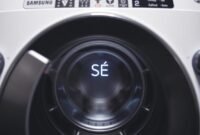Are you tired of your Whirlpool washer getting stuck on sensing? I’ve been there too. It’s really frustrating when your laundry stops mid-cycle. Many Whirlpool washer owners, like those with the WTW5500XW0 model, face this issue.
The washer’s lid locks up, the sensing light stays on, but nothing moves. It could be a problem with the shift actuator, the electronic control board, or a sensor issue. But don’t worry, I’m here to guide you through fixing this common problem.
Understanding Your Whirlpool Washer’s Sensing Mode
When you start a load of laundry, your Whirlpool washer goes through a special cycle. This cycle is designed to make washing better. It figures out the right amount of water and adjusts the cycle for each load.
How the Sensing Cycle Works
The sensing cycle starts right after you pick a wash program. The washer does several important things during this time:
- Locks the washer lid securely
- Activates the sensing light indicator
- Performs initial load distribution spins
- Calculates the precise amount of water needed
Normal Sensing Operation Sequence
My experience with Whirlpool washers shows a clear sensing mode operation. The washer first checks the load size and fabric type. Then, it decides on the best water level. This smart system saves water and cleans clothes well.
Purpose of the Sensing Feature
The sensing feature is key in modern washing tech. It analyzes the load to:
- Prevent over or under-filling water
- Protect delicate fabrics from damage
- Optimize detergent and water consumption
- Ensure balanced washing performance
Knowing how your washer’s sensing cycle works helps you see the advanced tech. It keeps your clothes clean and your washer running well.
Common Causes of Whirlpool Washer Stuck on Sensing
When your Whirlpool washer gets stuck in sensing mode, many technical issues could be the cause. Knowing these problems helps you fix the whirlpool washer sensing problem fast.
Several key parts might cause a stuck sensing mode in your washer. The most common problems include:
- Control board malfunctions
- Shift actuator failures
- Water level sensor complications
- Drain pump blockages
Let’s look at the main reasons for a stuck sensing mode in more detail.
Component Failure Analysis
| Component | Potential Issue | Replacement Cost |
|---|---|---|
| Actuator Switch | Mechanical failure preventing cycle start | $20-$100 |
| Control Board | Electronic sequencing errors | $200-$600 |
| Water Inlet Valve | Improper water flow detection | $20-$150 |
| Drive Motor | Speed sensing complications | $200-$700 |
Some washers might keep trying to work even when turned off. They need to be completely unplugged to stop the sensing cycle. An F1 Motor Control Fault error code might show a bigger electrical issue.
It’s best to get a professional to find out why your washer is stuck. This way, you avoid replacing parts that aren’t the problem.
Signs of a Malfunctioning Sensing System
When your Whirlpool washer starts having sensing system problems, it can be really frustrating. Knowing the early signs helps you fix issues before they get worse.
Spotting the signs of a malfunctioning sensing system can save you time and money. The control panel often gives clues about what’s wrong with your washer.
Flashing Sensing Light Indicators
A whirlpool washer sensing light flashing can mean several things are wrong. These lights usually show:
- Incorrect water level detection
- Load balance issues
- Sensor calibration errors
- Potential electrical connection problems
Unusual Sounds During Sensing
Strange noises during the sensing cycle might point to mechanical issues. Listen for:
- Grinding or scraping sounds
- Repetitive clicking
- Prolonged humming
- Whirring noises that seem out of place
Control Panel Response Issues
When your control panel stops working, it could mean deeper problems. Some common signs include:
| Symptom | Potential Cause |
|---|---|
| Buttons not registering | Control board malfunction |
| Random error codes | Sensor miscommunication |
| Cycle interruption | Calibration errors |
If your Whirlpool washer’s sensing system keeps having problems, getting a professional technician might be the best move. They can help diagnose and fix the issue right.
Read also: LG Washing Machine Error Code DE
Control Board Issues and Solutions
When you’re trying to fix a Whirlpool washer, the control panel is key. It’s like the brain of your washer, controlling everything.
Control board problems can show up in different ways. You might see:
- Intermittent sensing mode interruptions
- Unexpected error code displays
- Inconsistent machine response
- Complete failure to progress through wash cycles
Experts suggest certain steps to fix control panel issues:
- Do a full power reset
- Check the electrical connections
- Look for any visible damage
- Test each circuit part
Knowing about control board problems can help save money. Some issues might look hard but can be fixed with the right steps.
| Symptom | Potential Cause | Recommended Action |
|---|---|---|
| Persistent Sensing Mode | Circuit Malfunction | Professional Diagnostic Test |
| Erratic Control Panel | Electrical Surge Damage | Component Replacement |
| No Response | Complete Board Failure | Full Control Board Replacement |
While fixing things yourself might be tempting, control panel issues need expert knowledge. If you’re unsure, getting a pro to fix your Whirlpool washer is best.
Shift Actuator Problems and Diagnosis
When you’re fixing a Whirlpool washer, the shift actuator is key. It’s a small but important part that helps your washer work right. Knowing about its problems can save you a lot of trouble.
Identifying Actuator Failure
Spotting shift actuator issues takes some eye for detail. Look out for these signs:
- Washer stuck in sensing mode
- Unusual grinding or clicking noises
- Error code F7 E5 showing shifter fault
- Can’t move through wash cycles
Replacement Guidelines
Fixing your washer starts with a clear plan. I suggest using the S-W-R-S-D method for error codes.
Before you swap out the actuator, think about these points:
- Make sure the error code fits the symptoms
- Check if control panel issues are the real problem
- Compare the cost of a new actuator to buying a whole new washer
- Get a pro to check it out if you’re not sure
Replacing the actuator might fix sensing issues, but it’s not a sure thing. Some say control panel problems can look like actuator failures. So, getting a pro to look at it is a good idea.
Water Level and Pressure Switch Complications

It’s important to know about water level and pressure switch problems. The pressure switch helps your Whirlpool washer use the right amount of water for each load. This ensures your clothes get washed well.
When the pressure switch goes wrong, your washer might act up in several ways:
- It might not detect the water level right
- It could get stuck during the sensing cycle
- It might not fill up with water or fill too much
- It might stop washing unexpectedly
To find out if the pressure switch is the problem, you need to look at your washer’s water intake. A bad pressure switch stops the washer from knowing how much water it needs for different loads.
Read also: What Does SE Mean on a Samsung Washer
Signs that the pressure switch might be having trouble include:
- Water levels in the wash cycle are not steady
- The sensing mode keeps failing
- You hear strange noises when water is coming in
- The control panel shows error messages
| Pressure Switch Status | Potential Symptoms | Recommended Action |
|---|---|---|
| Faulty Connection | Erratic water filling | Check electrical connections |
| Mechanical Wear | No water intake | Replace pressure switch |
| Sensor Calibration Issue | Incorrect water amount | Reset or recalibrate system |
Getting a professional to check and fix your Whirlpool washer is key. If you keep having problems, it’s best to get help from a certified appliance tech.
Drain Pump Blockage and Maintenance
When you’re trying to fix your whirlpool washer, the drain pump is often a big problem. Many issues come from the pump, which can mess up the whole wash cycle.
Blockages in the drain pump are a big deal. Knowing how to find and fix these problems can save you a lot of time and money.
Clearing Hair and Debris
Debris can really slow down your washer. Here’s how to keep your pump working well:
- Unplug the washer before starting any maintenance
- Locate the drain pump filter (typically behind a panel)
- Remove accumulated hair, fabric fragments, and small objects
- Clean the filter thoroughly with warm water
- Check the pump impeller for any visible damage
Proper Pump Maintenance
Keeping your drain pump in good shape is important. Look out for these signs:
| Maintenance Step | Recommended Action |
|---|---|
| Impeller Position | Ensure impeller is 1/4″ from pump housing |
| Pump Performance | Check for smooth water discharge |
| Replacement Indicators | Replace if pump shows signs of wear or malfunction |
By following these tips, you can stop drain pump blockages and make your Whirlpool washer last longer. Regular checks and quick fixes are the best way to keep your washer running smoothly.
Diagnostic Mode and Error Codes
Learning about Whirlpool diagnostic tips can save you a lot of time and stress. Modern Whirlpool washers have advanced diagnostic systems. These systems quickly find and fix problems.
When your washer has a problem, it shows specific error codes. These codes help find the exact issue. Here are some common error codes you might see:
- Sud or Sd Code: Shows too much suds in the machine
- F5 E2 Code: Means there’s a problem with the door locking mechanism
- F8 E1 Code: Points to low water flow issues
To get into diagnostic mode on most Whirlpool washers, follow these steps:
- Unplug the washer for 1 minute
- Plug it back in
- Press and hold the “Cycle Select” and “Start/Pause” buttons at the same time
- Wait for diagnostic mode to start
Here’s a detailed look at important error codes:
| Error Code | Meaning | Potential Solution |
|---|---|---|
| F0E2 | Oversuds Condition | Use HE detergent, reduce detergent amount |
| F3E2 | Pressure System Fault | Check pressure hose connections |
| F8E3 | Overflow Condition | Inspect drain and pressure hose installations |
Pro tip: If you keep getting the same error codes, write them down. Then, if simple fixes don’t work, call a professional technician.
Step-by-Step Reset Procedures
Dealing with a stubborn Whirlpool washer can be frustrating. I’ll guide you through the best ways to reset your washer. This will get it working right again, fast and easy.
When your washer gets stuck in sensing mode, a proper reset can often resolve the issue. Knowing the right reset washer sensor techniques can save you time and money.
Power Cycling Methods
Power cycling is the simplest reset technique for your Whirlpool washer. Just follow these steps:
- Unplug the washer from the electrical outlet
- Wait for at least 5 minutes
- Plug the washer back in
- Run a test cycle to verify reset
Manual Reset Instructions
For a more detailed reset, try these manual methods:
- Press and hold the start/pause button for 3-5 seconds
- Use the control panel to enter diagnostic mode
- Check for error codes that might indicate specific issues
Remember, some Whirlpool washers may need more than one reset attempt. If these methods don’t work, it’s best to call a professional technician.
Preventive Maintenance Tips
Keeping your Whirlpool washer in top shape is all about proactive care. As a homeowner, I’ve found that regular maintenance can stop many common problems. It also helps your washer last longer. A good washer maintenance guide is key to avoiding sudden breakdowns.

Understanding key maintenance practices is the first step in Whirlpool washer troubleshooting. Here are some important tips to keep your washer working well:
- Clean the drain pump regularly to prevent hair and debris buildup
- Avoid overloading the washer to maintain proper sensing function
- Inspect water inlet valves and hoses monthly
- Use appropriate detergent amounts to prevent residue buildup
Some maintenance tasks are more critical than others. I suggest making a regular maintenance schedule. This helps catch problems before they get worse.
| Maintenance Task | Frequency | Benefits |
|---|---|---|
| Drain Pump Cleaning | Every 3 months | Prevents blockages and improves drainage |
| Hose Inspection | Monthly | Prevents water leaks and connection issues |
| Interior Drum Cleaning | Every 2 months | Removes detergent residue and prevents odors |
Be extra careful with loads that have pet items or heavy fabrics. These can put extra stress on your washer. By following these tips, you’ll greatly reduce the chance of sensing and performance problems.
About 75% of washing machine issues can be avoided with proper care and regular maintenance. A bit of effort can make your Whirlpool washer efficient for many years.
Conclusion
Dealing with Whirlpool washer repair can seem tough. But, knowing the right steps to take makes a big difference. I’ve learned that by carefully checking things, many problems can be fixed without needing a pro.
When you face Whirlpool washer sensing issues, first look at simple things. Check if the load is balanced, water connections are good, and electrical connections are secure. Often, problems are easy to fix and don’t need a lot of technical know-how. Using diagnostic mode can show you error codes that help find the exact problem.
Keeping your washer in good shape is key to avoiding problems. Clean the filters, use the right amount of detergent, and don’t overload it. Doing these things can really help prevent issues. While you can try to fix things yourself, some problems might need a pro to fix.
Being patient and methodical is the best way to tackle sensing cycle problems. By knowing how your washer works and taking care of it, you can make it last longer. This way, you can avoid sudden breakdowns.


